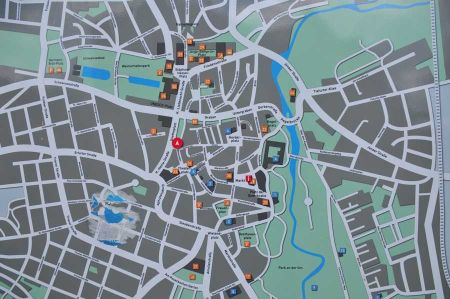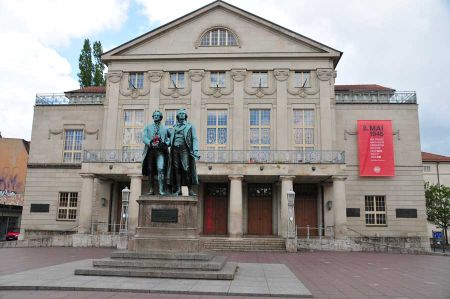Weimar – a walk using lovely alley of pedestrian zone
- Written by Portal Editor
After our so much impressing tour through the former Buchenwald concentration camp close to the city entry of the independent city of Weimar, which had proved to be much more time-consuming than planned, we first needed to talk, so that we were able to exchange first impressions and ideas.
It was visibly and noticeably difficult for all of us to immediately return to the planned daily routine. It's good that the vastness of the area on the Ettersberg next to Buchenwald camp offered space and atmosphere for a longer walk, so that one could sort out the buzzing thoughts in the mind.
A little later we drove down to the city centre of Weimar by car, because the city mostly covers an arch of the Ilm river southeast of the 478-metre-high Ettersberg, from which we had just left. The Ettersberg is the highest mountain in the entire Thuringian basin, the city itself lies about 200 meters above sea level. Weimar is worth a trip for its cultural heritage, names like Wieland, Goethe, Herder and Schiller are inextricably linked to the city. But politics has also left its historical traces here, so here in Weimar after the lost World War I and the dissolution of the Empire, the first republic on German soil was declared, the Weimar Republic in 1919.
In the centre of Weimar - parking near Goetheplatz

Before Goethe and Schiller became the legendary couple of friends of the Weimar Classic, who almost every day visited each other and not just exchanged literary, but also philosophically and scientifically, helped and motivated each other, they were real competitors. Goethe felt pressured by the younger man's growing fame. For him, Schiller was initially nothing more than an annoying reminder of his time in Werther and his own storm and urge, which has now been overcome. And Schiller saw person in the already established Goethe, who seemed unapproachable and arrogant to him at the first meeting (on September 7, 1788) that Charlotte von Lengefeld had put together, a "proud pride that one has to make a child to pretend humiliate the world ”. What connected the two rivals later was the mutual work on their own ideas, which is worth promoting and mutually enhancing in the intensive exchange of thoughts and feelings, was the declared purpose of this friendship, the history of which was no less than a decade "Practical test of the educational idea in the age of classical music". When Schiller died, an era came to an end for Goethe. The relationship had become so intimate that Goethe, when Schiller died - as he wrote in a letter to Carl Friedrich Zelter - thought he was losing half of his life, even losing himself.
Schiller and Goethe - eminent figures in the city
The Bauhaus is also one of the highlights
The current main building of the Bauhaus-Universität Weimar was built in 1906 according to plans by Henry van de Velde, who became the direct forerunner of the Grand Ducal Saxon Art School Weimar just one year later with the Grand Ducal Saxon School of Applied Arts Weimar, which he founded himself. In the Bauhaus, the traditionally separate areas of fine arts, applied arts and performing arts were combined on the basis of the concept, which in turn had a strong impact on painting, performing arts and music.
“The ultimate goal of all creative work is construction! […] Architects, sculptors, painters, we all have to go back to the craft! [...] The artist is an increase in the craftsman. "
- Walter Gropius: Bauhaus manifesto
On December 4, 1926, the new Bauhaus building designed by Walter Gropius was inaugurated. The fully glazed workshop wing on the street side was particularly impressive, as were the “master houses” that were built at the same time and also designed by Gropius, which functioned as residential houses and, like the Bauhaus building, consistently and exemplary combined the developed ideas of living and working.
Pedestrian zone - tall trees provide shade
We continue to the market square, where a large pottery market takes place today. Everywhere stands and suppliers of earthenware and sculptures, which are offered to visitors for sale. In the background the facades of the old town houses, so here too there is a colourful picture and hustle and bustle.
Weimar, we will be back, this time more relaxed and perseverance.
Please read as well:
Short trip to Erfurt - Krämer Bridge is of our special interest
Erfurt - the ensemble of cathedral and Severi Church
-
-
-
-
-
-
-
-
-
-
-
-
-
-
-
https://www.alaturka.info/en/germany/thuringia/5079-weimar-a-walk-using-lovely-alley-of-pedestrian-zone/amp#sigProIdc3c4eee833
